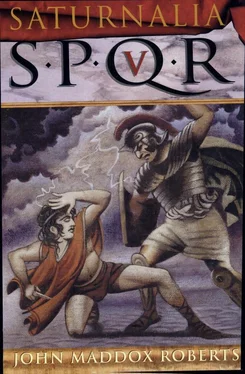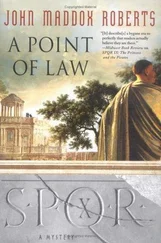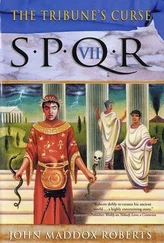John Roberts - Saturnalia
Здесь есть возможность читать онлайн «John Roberts - Saturnalia» весь текст электронной книги совершенно бесплатно (целиком полную версию без сокращений). В некоторых случаях можно слушать аудио, скачать через торрент в формате fb2 и присутствует краткое содержание. Год выпуска: 0101, ISBN: 0101, Издательство: St. Martin, Жанр: Исторический детектив, на английском языке. Описание произведения, (предисловие) а так же отзывы посетителей доступны на портале библиотеки ЛибКат.
- Название:Saturnalia
- Автор:
- Издательство:St. Martin
- Жанр:
- Год:0101
- ISBN:9780312320188
- Рейтинг книги:4 / 5. Голосов: 1
-
Избранное:Добавить в избранное
- Отзывы:
-
Ваша оценка:
- 80
- 1
- 2
- 3
- 4
- 5
Saturnalia: краткое содержание, описание и аннотация
Предлагаем к чтению аннотацию, описание, краткое содержание или предисловие (зависит от того, что написал сам автор книги «Saturnalia»). Если вы не нашли необходимую информацию о книге — напишите в комментариях, мы постараемся отыскать её.
Saturnalia — читать онлайн бесплатно полную книгу (весь текст) целиком
Ниже представлен текст книги, разбитый по страницам. Система сохранения места последней прочитанной страницы, позволяет с удобством читать онлайн бесплатно книгу «Saturnalia», без необходимости каждый раз заново искать на чём Вы остановились. Поставьте закладку, и сможете в любой момент перейти на страницу, на которой закончили чтение.
Интервал:
Закладка:
PatricianThe noble class of Rome.
PlebeianAll citizens not of patrician status; the lower classes, also called plebs.
Popular AssembliesThere were three: the centuriate assembly (comitia centuriata)and the two tribal assemblies: comitia tributa and consilium plebis, q.v.
PopularesThe party of the common people.
Princeps: “First Citizen”An especially distinguished senator chosen by the censors. His name was the first called on the roll of the Senate and he was first to speak on any issue. Later the title was usurped by Augustus and is the origin of the word “prince.”
PriesthoodsIn Rome, the priesthoods were offices of state. There were two major classes: pontifexesand flamens .Pontifexes were members of the highest priestly college of Rome. They had superintendence over all sacred observances, state and private, and over the calendar. Head of their college was the pontifex maximus , a title held to this day by the pope. The flamens were the high priests of the state gods: the Flamen Martialis for Mars, the Flamin Quirinalis for the deified Romulus, and, highest of all, the Flamen Dialis , high priest of Jupiter. The Flamen Dialis celebrated the Ides of each month and could not take part in politics, although he could attend meetings of the Senate, attended by a single lictor. Each had charge of the daily sacrifices wore distinctive headgear,and were surrounded by many ritual taboos.
Another very ancient priesthood was the Rex Sacrorum , “King of Sacrifices.” This priest had to be a patrician and had to observe even more taboos than the Flamen Dialis . This position was so onerous that it became difficult to find a patrician willing to take it.
Technically, pontifexes and flamens did not take part in public business except to solemnize oaths and treaties, give the god’s stamp of approval to declarations of war, etc. But since they were all senators anyway, the ban had little meaning. Julius Caesar was pontifex maximus while he was out conquering Gaul, even though the pontifex maximus wasn’t supposed to look upon human blood.
Rostra (sing, rostrum)A monument in the Forum commemorating the sea battle of Antium in 338 B.C., decorated with the rams, rostra , of enemy ships. Its base was used as an orator’s platform.
SaturnaliaFeast of Saturn, December 17–23, a raucous and jubilant occasion when gifts were exchanged, debts were settled, and masters waited on their slaves.
SenateRome’s chief deliberative body. It consisted of three hundred to six hundred men, all of whom had won elective office at least once. It was a leading element in the emergence of the Republic, but later suffered degradation at the hands of Sulla.
Sibylline BooksThese mysterious books of prophecies were brought to Rome in legendary times and were kept by a college of priests called, in pedantic Roman fashion, the Quin-quedecemviri (the Fifteen Men). In times of extraordinary calamity the Senate could order a consultation of the Sybilline Books. The prophecies were usually interpreted to mean that the gods wanted a foreign deity brought to Rome. Thus Rome built a temple to Ceres, a goddess of Asia Minor, and others. When the deity was Greek, the rites remained in the Greek rather than the Roman fashion.
SoothsayersThe Roman government used two types: First were the augurs. These were actual officials who belonged to a college and it was a great honor for a Roman to be adopted into the College of Augurs. They interpreted omens involving heavenly signs: lightning and thunder, the flight and other behavior of birds, etc. There were strict guidelines for this and personal inspiration was not involved. An augur could call a halt to all public business while he watched for omens. The augur wore a special, striped robe called a toga trabaea and carried a crook-topped staff called a lituus , which survives to this day as a part of the Roman Catholic bishop’s regalia.
The second type was the haruspex (pl. haruspices ). These were not officials but professional soothsayers and most were Etruscans. They took omens by examining the livers and other organs of sacrificial animals. Highly educated Romans considered them fraudulent but the plebs insisted on taking the haruspices (the term also referred to the omens themselves) before embarking on any important public project.
Official Roman soothsayers did not predict the future, a practice that was, in fact, forbidden by law. Omens were taken to determine the will of the gods at that time . They had to be taken repeatedly because the gods could always change their minds.
SPQR Senatus populusque Romanus . The Senate and people of Rome. The formula embodying the sovereignty of Rome. It was used on official correspondence, documents, and public works.
Tarpeian RockA cliff beneath the Capitol from which traitors were hurled. It was named for the Roman maiden Tarpeia who, according to legend, betrayed the Capitol to the Sabines.
Temple of SaturnThe state treasury was located in a crypt beneath this temple. It was also the repository for military standards.
Temple of VestaSite of the sacred fire tended by the vestal virgins and dedicated to the goddess of the hearth. Documents, especially wills, were deposited there for safekeeping.
TogaThe outer robe of the Roman citizen. It was white for the upper class, darker for the poor and for people in mourning. The toga praetexta, bordered with a purple stripe, was worn by curule magistrates, by state priests when performing their functions, and by boys prior to manhood. The toga picta,purple and embroidered with golden stars, was worn by a general when celebrating a triumph, also by a magistrate when giving public games.
TranstiberA newer district on the left or western bank of the Tiber. It lay beyond the old city walls.
Triumvir A member of a triumvirate-a board or college of three men. Most famously, the three-man rule of Caesar, Pompey, and Crassus. Later, the triumvirate of Antonius, Octavian, and Lepidus.
VigilesA night watchman. The vigiles had the duty of apprehending felons caught committing crimes, but their main duty was as a fire watch. They were unarmed except for staves and carried fire buckets.
WitchesThe Romans recognized three types. Most common were saga , “wise women” who were simply herbalists and specialists in traditional cures for disease and injury. More ominous were striga , true witches (“strega” still means witch in modern Italian). These could cast spells, had the power of the evil eye, could lay curses, and so forth. Most feared were venefica “poisoners.” Ancient peoples had a supernatural dread of poison and lumped its use together with sorcery rather than pharmacology. The punishments for poisoning were dreadful even by Roman standards. The Romans associated all forms of witchcraft and magic with the Marsians, a neighbor people who spoke the Oscan dialect.
Интервал:
Закладка:
Похожие книги на «Saturnalia»
Представляем Вашему вниманию похожие книги на «Saturnalia» списком для выбора. Мы отобрали схожую по названию и смыслу литературу в надежде предоставить читателям больше вариантов отыскать новые, интересные, ещё непрочитанные произведения.
Обсуждение, отзывы о книге «Saturnalia» и просто собственные мнения читателей. Оставьте ваши комментарии, напишите, что Вы думаете о произведении, его смысле или главных героях. Укажите что конкретно понравилось, а что нет, и почему Вы так считаете.









